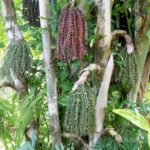The Alocasia Polly, or Elephant Ear plant, is a beautiful and unique houseplant that is gaining popularity. Also known as the African Mask plant, this variety belongs to the Araceae family and is native to Asia. With its striking foliage, the Alocasia Polly makes a stunning addition to any home or office space, and it is believed to bring good fortune and prosperity according to feng shui principles.
 The Alocasia Polly, a beautiful houseplant
The Alocasia Polly, a beautiful houseplant
This plant is characterized by its lush, green, heart-shaped leaves, which can grow to be 20-30cm long and 10-20cm wide. The leaves feature prominent white veins running through them, creating a stunning contrast. The Alocasia Polly typically grows to a height of 30cm to 1 meter, with its stem remaining underground, and its light green petiole emerging from the base to support the large leaves.
1 The Significance of the Alocasia Polly in Feng Shui
In feng shui, plants that are compatible with an individual’s m命 (life path) are believed to attract wealth and good fortune. The Alocasia Polly is considered a lucky plant, symbolizing prosperity and positive energy, while warding off negative influences. It is thought to bring good luck and protect those who are compatible with it from misfortune in their personal and professional lives.
 Attract wealth and prosperity with the Alocasia Polly
Attract wealth and prosperity with the Alocasia Polly
Aside from its feng shui significance, the Alocasia Polly makes an excellent houseplant due to its hardy nature and ease of care. Its striking, well-defined leaves make it a beautiful decorative piece for any home or office.
2 How to Grow and Care for the Alocasia Polly
Soil: The Alocasia Polly thrives in moist, well-drained soil that is rich in nutrients.
Location: This plant prefers bright, indirect light. Choose a spot near a window, balcony, or doorstep where it can receive ample light without being exposed to direct sunlight.
 The Alocasia Polly is easy to care for
The Alocasia Polly is easy to care for
Temperature: The ideal temperature range for the Alocasia Polly is 15.6°C to 26.7°C. Temperatures below 15°C can cause leaf rot and drop, and it does not fare well in air-conditioned rooms or drafty areas.
Watering: Water the plant sparingly but frequently throughout the day to ensure it receives adequate hydration.
Fertilizer: Fertilize the plant regularly, approximately once a month. For best results, dilute the fertilizer in water and apply it directly to the soil.
The Alocasia Polly is indeed a feng shui plant that not only brings good luck but also adds a touch of natural beauty to any living or working space. We hope this article has provided you with valuable insights into the care and significance of this wonderful plant.
2023 Lunar New Year Gift Ideas for Older Family and Friends
As 2021 approaches, families worldwide are gathering to celebrate the special bond between grandparents and their grandchildren. To show their love and admiration, these thoughtfully chosen gifts will bring a smile to the face of the elderly. Here, we have compiled a list of the 13 most meaningful Tet presents that can bring joy to our beloved grandparents.






































